D iversity issues related to the high-tech industry can’t be missed in the news today. Whether it is a story about pay inequity among men and women, or research showing that the industry workforce composition is largely homogeneous, the headlines are unavoidable. CompTIA’s new research found that 7 in 10 people working in the high-tech industry today say they have heard or read about workplace diversity issues in the last 12 months.
And that has sparked much discussion. This report reflects the views and experiences of high-tech workers of all races, genders, ages and job roles on the topics of diversity and inclusion.
Key Points
The diversity discussion is often contradictory
Consider the following data points: nearly 8 in 10 high-tech industry workers say they are satisfied with their organization’s diversity efforts, 44% say diversity is a high priority for their employers, and 87% say they’ve
worked in a department comprised of a diverse group of employees in the last year. At the same time, 45% say the industry has lagged in promoting diversity, a position backed by statistics from the U.S. Equal Employment Opportunity Commission that
find a workforce overwhelmingly white and male, with fewer African Americans, women and Hispanics than non-tech industries.
The gender gap is widest when it comes to pay equity
Pay inequity resonates loudly with women, no surprise. Two-thirds of women in high tech said they would leave their job if they discovered pay imbalances among employees doing equal work. That compares with 44% of men who said the same.
Promotions are an issue too. A report last year by non-profit Ascend Foundation found that Asian Americans were least likely of all races to reach management level despite having more workers in the sector than other non-white races.
Diverse workforces spur innovation
Sixty-four percent of respondents said they agree that an organization with a heterogeneous employee base is more likely to produce world-class innovation than one with that is largely homogeneous in makeup. Another 28% at least partially
agree with that premise, while just 9% disagree. The near-consensus on diversity’s impact on innovation spans all segments of the survey sample, including small, medium and large organizations, all age groups, genders, races and ethnicities.
Hiring the most qualified candidate carries weight
Of all the actions that an organization can take to get a passing grade when it comes to diversity, hiring the best candidate for the job tops the list. Forty-eight percent of respondents said this is what they value most. Other things
they find important: a human resources department that actively recruits a diverse workforce; a top-down corporate culture that is diversity-friendly; an environment where diversity efforts do not overshadow all other strategic goals; formal inclusion
initiatives to reduce turnover among minority employees; and the existence of an official diversity policy/report.
HIGH TECH AND DIVERSITY
Whether it is a headline about an engineer fired for writing a controversial position paper on gender, or the sobering fact that the number of African Americans working in the tech industry hovers in single-digit territory, the tech sector is having a reckoning of sorts on the topic of workplace diversity and inclusion.
Diversity issues can’t be missed in the news. CompTIA’s study found that 7 in 10 people working in the high-tech industry today say they have heard or read about workplace diversity issues in the last 12 months. Of that 70% of respondents, 4 in 10 found these accounts to be generally positive and focused on the progress the industry is making around diversity and inclusion. Conversely, 3 in 10 instead view these news report as negative in nature, focused on problems the high tech industry has with diversity and inclusion among its workforce. Another 31% call what they have read or seen a bit of both good and bad.
Clearly, opinion and experience can differ widely when it comes to a sensitive topic such as the high-tech industry’s record on workplace diversity, and this report will detail many of those positions. But the numbers tell an objective story. The U.S. Equal Employment Opportunity Commission (EEOC) conducted a comprehensive study called Diversity in High Tech that has served as a solid benchmark of diversity statistics. Consider several of its findings:
- Compared with overall private industry, the high-tech sector employed a larger share of white workers (68.5% vs 63.5%), Asian Americans (14% vs 5.8%), and men (64% vs 52%), while a smaller share of African Americans (7.4% vs 14.4%), Hispanics (8% vs 13.9%), and women (36% vs 48%).
- In the tech sector nationwide, whites are represented at a much higher rate in executive-level roles than African Americans, Hispanics and Asian Americans. Furthermore, by gender, men occupy 80% of executive roles compared with 20% for women. That compares with the overall private sector, where 71% of executive positions are held by men and 29% occupied by women.
- In Silicon Valley specifically, employment of women and men in non-technology industry firms is at about parity with 49% women and 51% men. That compares to a 30% participation rate for women at 75 leading tech firms that the EEOC documented.
What’s more, even among high-tech firms that employ a more diverse workforce, the majority of their tech-specific jobs, such as coding, are held by white workers, mainly men. Minorities and women in high-tech companies – exclusive of Asians – tend to serve in non-technical positions.
Retention is also a major consideration. Consider this 2017 statistic from the Center for Talent Innovation: women who do work in technical fields leave their jobs at a 45% higher rate than men do. Much of this attrition is attributed to corporate culture issues, lack of inclusion, pay inequity or other forms of individual or institutional bias.
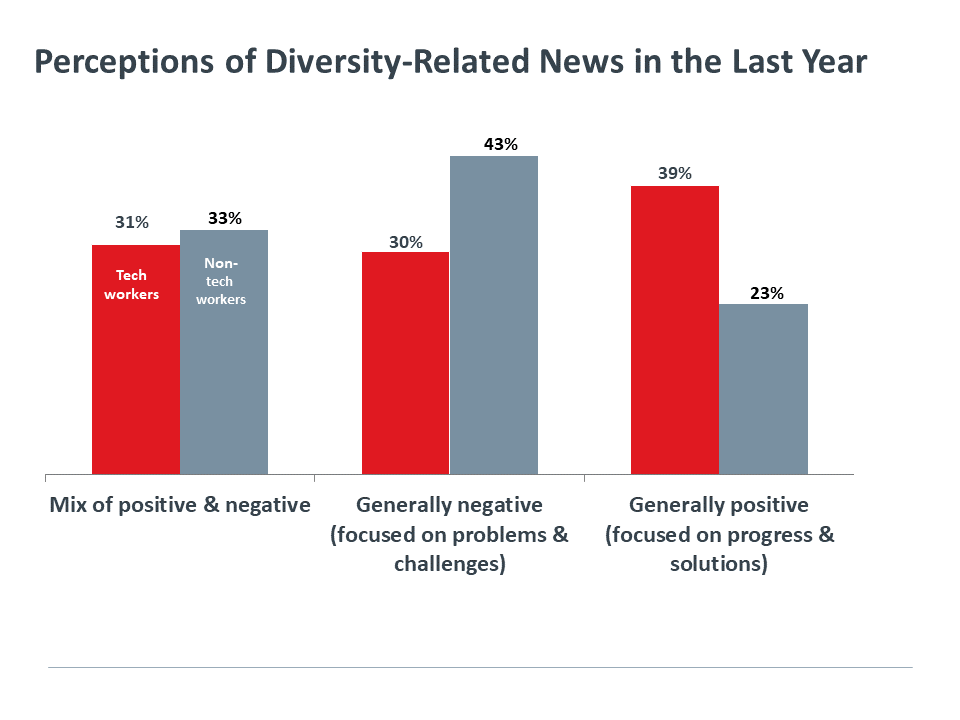
That said, many tech companies today are putting effort into diversifying their workforces and creating environments in which employees of all backgrounds feel included and able to contribute. Recruitment and hiring efforts have ramped up in the past few years, as has implementation of formal processes and best practices such as issuing annual diversity reports.
Apple, for example, issued its diversity report last fall under the stewardship of its newly appointed vice president of diversity and inclusion, Denise Young Smith. In it, some strides are evident: From July 2016 to July 2017, half of the company’s new hires in the U.S. were from historically underrepresented groups in the high-tech industry. The new hires also reflect more diversity than its current employees. For example, 11% of Apple’s new hires were African American compared to its current black employee population of 9%. These improvements, however, still place the company – and most of its contemporaries – behind the eight ball when it comes to a truly diverse workforce.
It should be noted also that major tech firms such as Apple, with its roughly 83,000 U.S. employees, have resources for deeper diversity efforts. Many SMB firms deal with challenges that larger companies do not, such as being located in a geographic region with a mostly homogeneous workforce pool or lacking a human resources staff to spearhead recruiting.
THE HIGH-TECH WORKPLACE
CompTIA’s study features data collected from respondents who work in the high tech industry, as well as from employees in other industries such as manufacturing, retail, healthcare etc. For purposes of this report, we refer to the latter category of respondents as “general business.” High-tech respondents were comprised of technology vendors, ISVs, distributors, solution providers, managed services providers, telecom channel agents, and digital marketing agencies.
The objectives of the study included having respondent’s assess and grade their own workplace on its diversity standing and efforts, as well as to evaluate individual workers’ attitudes about the state of diversity in the tech industry. Is it a priority? Do you see diversity reflected in your own work environment? Are there official policies and processes in place to hire, retain, and promote workers of historically under-represented backgrounds?
When it comes to who bears responsibility for setting a tone and agenda that encourages and supports workplace diversity, respondents agree that many constituents have a role: the company itself, individual workers, federal and state governments, and the courts. Roughly 7 in 10 of both high-tech and general business workers, however, believe ultimate responsibility lies with company leaders. Clearly, this makes sense as the top brass in any organization tend to dictate culture, work environment, and policies around hiring practices and promotions.


Interestingly, respondents in an executive-level role at their organizations put less of the onus for diversity tone-setting on company leaders than did middle managers and staff level workers. Sixty percent of executives said the company has prime responsibility, compared with 80%, respectively, of the other two sets of respondents.
Instead, executives placed more emphasis on individual workers for setting tone and agenda around diversity, with 35% of them saying individuals shoulder primary responsibility. That compares with just 12% of middle managers and 9% of staff who believe the buck stops with individual workers.
While this might seem self-serving on the part of executive-level managers looking to avoid sole accountability for diversity efforts, it’s also smart policy. Cliché as it sounds, building and fostering diversity in the workplace takes a village. Recruiting from a diverse talent pool is just a first step; creating an inclusive, non-hostile and fair environment that will retain minority workers and see them flourish is just as important. Consider that 3 in 10 non-white high-tech workers in the study said they left a job because of a lack of diversity or hostile culture. Fixing this takes team effort.
Ironically, the vast majority of high-tech workers say they are satisfied with the diversity efforts of their companies, though statistics from EEOC and other government sources continue to reveal an industry workforce that is predominantly white and male. One theory for the positivity? Lagging diversity has played large in the news of late, and the media spotlight may be signaling to workers that companies are growing more aware of the need to step up their efforts to employ a more varied set of employees.
MYTH, PERCEPTION OR REALITY?
As previously indicated, the high-tech industry has garnered its fair share of media coverage related to workplace diversity in the past several years. Much of the reporting has been negative, calling out the industry on a raft of issues from sexism and ageism in the office to conscious and unconscious bias in hiring and recruiting strategies. Case in point, a Pew Research report released in January highlights a pervasive problem of racial and gender bias among STEM-oriented workers, especially those working within the high-tech industry. The same study also throws cold water on the often-cited reason for lack of diversity in the tech industry; namely, a “pipeline” problem caused by a dearth of minority and women job candidates. Pew’s African American and Hispanic respondents undercut this argument. A majority of these respondents told Pew they were indeed in the pipeline, seeking high-tech industry jobs. Yet they either weren’t selected for the job after their interview process, or they were hired but left their employment thereafter due to diversity issues in the workplace.
There are nuances, of course, and the industry has been working to diversify its employee base and increase awareness about inclusion and sensitivity. In an attempt to understand what high-tech industry workers themselves think about media characterizations and the state of diversity in their industry, CompTIA’s study focused in part on what they think about several commonly held perceptions/stereotypes/facts in the news today. Respondents were asked whether they agreed or disagreed with a statement, and to what degree.
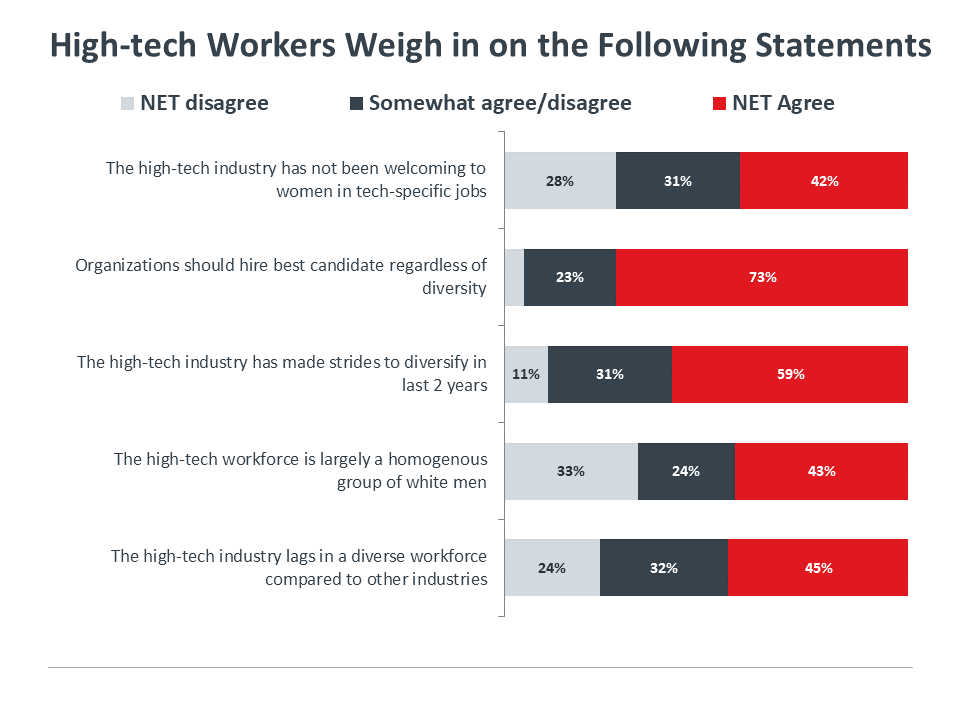
Overwhelmingly, and regardless of their racial, gender or age status, respondents agree that organizations should hire the best candidate for the job without regard for diversity. While this does not mean that organizations should not actively recruit and seek a diverse set of job candidates, the inference in the data is that hiring decisions, ultimately, should be predicated on the most-qualified person for the job. What many experts on workplace diversity contend, however, is that the metrics by which a candidate is measured can unwittingly hold bias based on the viewpoint of the person doing the hiring. For example, a white man might define qualification characteristics in a very different way than a woman or minority in the hiring role might. Experts urge companies to consider such things as a candidate’s socioeconomic background, for example, as a measure of how many hurdles they may have had to overcome to reach this point in their career. These contributing factors could make a candidate best for the job.
Four in 10 respondents agreed that the high-tech industry has not been as welcoming to hiring women for tech-specific jobs, a view nearly identical among men (40%) and women (43%). It’s an interesting finding, given that 43% of all respondents also agreed that the high-tech workforce is largely a homogeneous group of white males, while another 24% at least partially agree with that premise. Non-whites agreed with the statement in slightly higher numbers (46% vs 41% of white respondents).
What is most surprising is that a full third of all respondents disagree that white males comprise the majority of the high-tech industry workforce, while another 24% at least partially disagree that that is the case. Workforce demographics numbers from the EEOC, Pew and other third-party and governmental groups simply do not bear this out for the U.S. marketplace. A partial explanation for the response could be aspirational in nature; namely that employees like to think that they work in a diverse, inclusive culture – whether they do or not. Other factors could be in play too; for example working in a diverse department such as call-center customer service could lead an individual worker to overestimate the company’s overall workforce composition.
When it comes to whether the high-tech industry as a whole lags other industries in having a diverse workforce, 45% of respondents say yes, while another third at least partially agree. A quarter of respondents do not agree. Within this premise, there is a divide between white and non-white workers. Fifty-four percent of non-white workers say diversity in the high-tech world falls behind other industries, compared with 39% of white workers who feel similarly. Of non-white workers that agree, 22% do so strongly vs. 11% of white employees. On an optimistic note, a majority of workers feel things are changing in high tech, with 59% of all respondents saying the industry has made strides toward a more diverse workforce in recent years.
MYTH, PERCEPTION OR REALITY? TAKE 2
Whether or not the high-tech industry employs a broadly diverse workforce – and by the numbers, it does not – the majority of workers in the ecosystem today see at least one major business benefit to diversity and inclusion: innovation. Sixty-four percent of respondents said they agree that an organization with a heterogeneous employee base is more likely to produce world-class innovation than one that is largely homogeneous in makeup. Another 28% at least partially agree with that premise, while just 9% disagree.
The near-consensus on diversity’s impact on innovation spans all segments of the survey sample, including small, medium and large organizations, all age groups, genders, races and ethnicities. The only significant gap in the numbers is just marginally different. Among those that agree generally with the statement, 33% of non-whites said they “strongly agree,” compared to 23% of whites who did.
What’s difficult to reconcile given this rosy view of innovation and diversity is the high percentage of respondents who also said it is a myth that the high-tech industry does not promote diversity. Many experts on the subject describe this dichotomy in psychological terms; namely that diversity is an “empty word” in corporate America, meaning companies often talk a good game, hire diversity officers, develop diversity statements etc., but practically speaking enact little change in the overall makeup of their workforce. In line with that thinking, it is possible that study respondents’ agreement with this “diversity myth” statement constitutes a prime example of them giving their industry a perceived “A” for effort in an aspirational sense, but not realizing actual results.
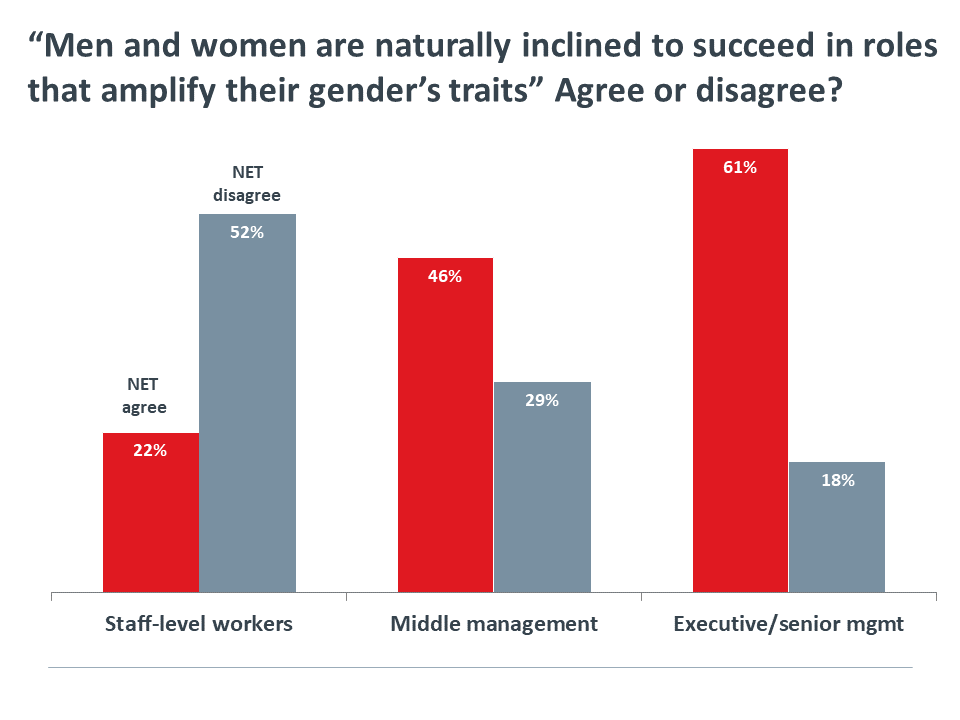

One of the more curious findings in this data set relates to gender. Asked if women and men are naturally inclined to succeed in roles that amplify their gender traits, nearly half of respondents agreed, with another quarter saying they partially agreed. Along gender lines, unsurprisingly female respondents agreed less with the premise (41%) than did their male counterparts (51%). But the real discrepancy occurs when the answers to the gender question are segmented by job type. As shown in the chart to the left, among executives/senior managers, 61% agreed with the statement about men and women, compared with 46% of middle managers, and 22% of staff-level workers.
What accounts for this wide opinion gap? CompTIA cannot say definitively, though one possible reason so many executive-level respondents believe women and men succeed more in roles that play to gender traits is that the vast majority of senior managers in the high-tech industry are men. Women in high tech, who generally disagree more than men do with the gender statement, are more likely to be working in positions in middle management or at the staff level, which could explain the disparity of the responses by job role.
DIVERSITY: INDIVIDUAL EXPERIENCES
Beyond gauging their general perceptions of the industry and their own organizations’ position and performance on workplace diversity, respondents were also asked about their individual viewpoints and experiences at work.
Most high-tech workers agree that a diverse workplace is to some degree desirable, either mandated or encouraged by an organization. Breaking that down, 43% of respondents said they personally believe that workplace diversity is critical to have and that employers should mandate a mix of employees of different races, ethnicities, genders, ages, etc. An near-equal percentage of high-tech respondents (44%) said that workplace diversity is nice to have, meaning organizations should actively encourage and promote it. In the minority, 13% said a diverse workforce is not necessary and that it is preferable to hire people based on their ability to help reach strategic goals versus a diversity objective.
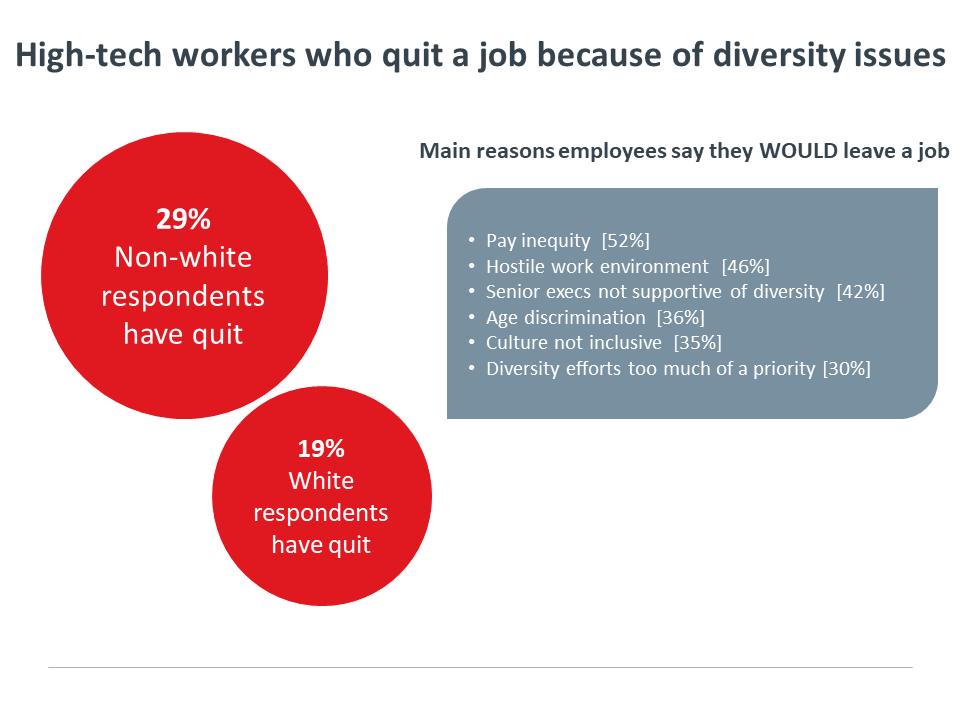
Among general business respondents from other industries, viewpoints on workplace diversity hewed mostly to their counterparts’ in high tech, though a higher percentage (48%) deemed workplace diversity critical to have. However, that five-point difference was balanced out by a slightly higher percentage of general business respondents (17%) that said a diverse workplace was not necessary.
Segmenting the data further reveals more differences between high-tech workers and those in other industries. There are also gaps between the opinions of executive-level employees in high tech vs. staff level.
At the executive-level job role, 59% of high-tech workers said they personally believe a diverse workplace is critical to have and should be an organizational mandate. That compares with 49% of executives in the general business population. But at the staff level for these two groups, just 28% of high-tech workers characterized diversity as critical to have vs. 48% of those from the general business bucket.
As the diversity conversation around the high-tech industry has swelled in the past few years, executives and business owners have been under pressure to enact change in the form of more inclusive policies and hiring practices, and more. As the leaders of their organizations, they are also expected to promote a diverse workplace as a strategic goal, which likely explains the high percentage of them that believe the effort to be critical.
As detailed above, staff-level general business workers deem diversity efforts more critical than staffers in high tech. One possible reason? Because other industries tend to be more diverse in their rank and file workforce, they may have a better appreciation of the benefits gained from working in a heterogeneous environment – and therefore value it more.
| Diversity measures taken by high-tech businesses | Currently has | Plans to add |
| Established hiring initiatives aimed at recruiting/retaining diverse workforce | 60% | 15% |
| Focuses on team-level diversity/inclusion in work projects/company events | 59% | 18% |
| Creates “safe spaces” for employees to discuss diversity issues | 51% | 18% |
| Sponsors/participates in diversity events | 44% | 21% |
| Issues diversity report | 36% | 23% |
DIVERSITY: INDIVIDUAL EXPERIENCES – TAKE 2
In tough economic times, workers are more likely to hold onto the job they have even if they are unhappy with the culture, pay or lack of diversity among their colleagues. That’s less the case today because of record-low unemployment and high-demand for skilled labor in the high-tech industry. Workers now have greater leverage in choosing where to work or whether to stay in the job they currently hold.
And for some who are unhappy with their company’s record on diversity, they leave. Three in 10 non-white respondents said they have left a job in the last year because of diversity-related issues within their organization. Across the total high-tech sample, 23% said they had quit a job for diversity reasons, compared similarly with 20% of workers in the general business sample.
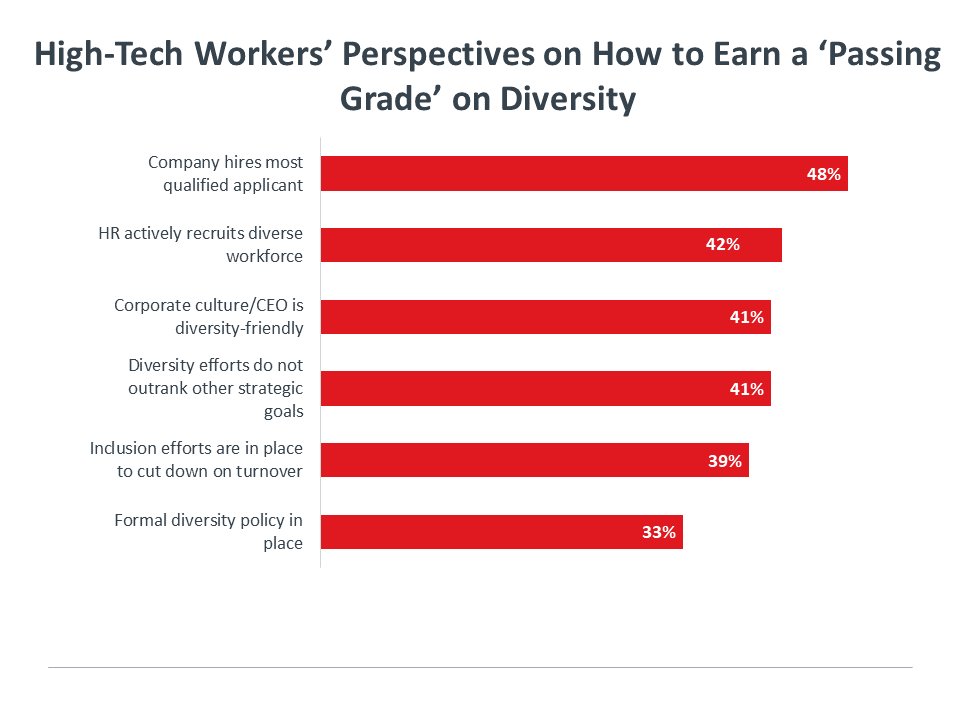
Among the sizable percentage (77%) of high-tech workers who have never left a job because of a problem with diversity, a portion aren’t ruling out the possibility. Twenty-six percent of them said that they would leave a job if confronted with bias or other diversity/inclusion issues in the future. That percentage spikes to 35% among non-white, high-tech respondents, compared with 21% of the white sample. There’s also an age gap. Thirty-five percent of high-tech workers 20-to-34 years old said they’d leave a job due to a diversity issue, vs. 20% of high-tech employees 35-to-49 years old.
That’s not entirely surprising given that younger workers haven’t yet settled fully into a career, tend to be willing to job hop, and may not yet have financial responsibilities that make it a difficult choice to leave a job for any reason. Then again, many do have loads of student debt to erase.
Main reasons employees say they would leave a job
- Pay inequity [52%]
- Hostile work environment [46%]
- Senior execs not supportive of diversity [42%]
- Age discrimination [36%]
- Culture not inclusive [35%]
- Diversity efforts too much of a priority [30%]
Why specifically do people quit a job over a diversity or bias issue? Respondents cited myriad tripwires, from pay inequity and age discrimination to fatigue with a company placing “too much emphasis” on its diversity initiatives and efforts.
Pay inequity resonates loudly with women, no surprise. Two-thirds of women in high tech said they would leave their job if they discovered pay imbalances among employees doing equal work. That compares with 44% of high-tech men who said the same. The tech industry sports some of the highest salaries in the country, which is one of the reasons it is such a popular field to enter. But the dirty little secret is that despite a higher salary benchmark than other industries, the pay gap between men and women in high tech exists nonetheless. Consider some findings from a survey done last year by salary database and jobs site Comparably. It found that in the tech-dominated metropolitan area of Seattle, men earned an average of 30% more in base salary plus bonuses than women. In Boston, another tech hub, the gap was 33%.
The pay gap manifests in another way in the high-tech industry: promotions. For example, a report last year by non-profit professional association Ascend Foundation found that Asian Americans were least likely of all races to reach management-level or higher in the tech industry despite having more workers in the industry than all other non-white races.
Another obvious factor that would lead an employee to leave their job is a hostile work environment, which could run the gamut from a case of overt individual harassment or something more systemic such as a culture that is not inclusive or is unknowingly biased in its decisions and policies. Surprisingly, age discrimination as a reason to quit drew equal percentages from those aged 20 to 50 years.
DIVERSITY: INDIVIDUAL EXPERIENCES
Beyond gauging their general perceptions of the industry and their own organizations’ position and performance on workplace diversity, respondents were also asked about their individual viewpoints and experiences at work.
Most high-tech workers agree that a diverse workplace is to some degree desirable, either mandated or encouraged by an organization. Breaking that down, 43% of respondents said they personally believe that workplace diversity is critical to have and that employers should mandate a mix of employees of different races, ethnicities, genders, ages, etc. An near-equal percentage of high-tech respondents (44%) said that workplace diversity is nice to have, meaning organizations should actively encourage and promote it. In the minority, 13% said a diverse workforce is not necessary and that it is preferable to hire people based on their ability to help reach strategic goals versus a diversity objective.

Among general business respondents from other industries, viewpoints on workplace diversity hewed mostly to their counterparts’ in high tech, though a higher percentage (48%) deemed workplace diversity critical to have. However, that five-point difference was balanced out by a slightly higher percentage of general business respondents (17%) that said a diverse workplace was not necessary.
Segmenting the data further reveals more differences between high-tech workers and those in other industries. There are also gaps between the opinions of executive-level employees in high tech vs. staff level.
At the executive-level job role, 59% of high-tech workers said they personally believe a diverse workplace is critical to have and should be an organizational mandate. That compares with 49% of executives in the general business population. But at the staff level for these two groups, just 28% of high-tech workers characterized diversity as critical to have vs. 48% of those from the general business bucket.
As the diversity conversation around the high-tech industry has swelled in the past few years, executives and business owners have been under pressure to enact change in the form of more inclusive policies and hiring practices, and more. As the leaders of their organizations, they are also expected to promote a diverse workplace as a strategic goal, which likely explains the high percentage of them that believe the effort to be critical.
As detailed above, staff-level general business workers deem diversity efforts more critical than staffers in high tech. One possible reason? Because other industries tend to be more diverse in their rank and file workforce, they may have a better appreciation of the benefits gained from working in a heterogeneous environment – and therefore value it more.
| Diversity measures taken by high-tech businesses | Currently has | Plans to add |
| Established hiring initiatives aimed at recruiting/retaining diverse workforce | 60% | 15% |
| Focuses on team-level diversity/inclusion in work projects/company events | 59% | 18% |
| Creates “safe spaces” for employees to discuss diversity issues | 51% | 18% |
| Sponsors/participates in diversity events | 44% | 21% |
| Issues diversity report | 36% | 23% |
DIVERSITY: INDIVIDUAL EXPERIENCES – TAKE 2
In tough economic times, workers are more likely to hold onto the job they have even if they are unhappy with the culture, pay or lack of diversity among their colleagues. That’s less the case today because of record-low unemployment and high-demand for skilled labor in the high-tech industry. Workers now have greater leverage in choosing where to work or whether to stay in the job they currently hold.
And for some who are unhappy with their company’s record on diversity, they leave. Three in 10 non-white respondents said they have left a job in the last year because of diversity-related issues within their organization. Across the total high-tech sample, 23% said they had quit a job for diversity reasons, compared similarly with 20% of workers in the general business sample.

Among the sizable percentage (77%) of high-tech workers who have never left a job because of a problem with diversity, a portion aren’t ruling out the possibility. Twenty-six percent of them said that they would leave a job if confronted with bias or other diversity/inclusion issues in the future. That percentage spikes to 35% among non-white, high-tech respondents, compared with 21% of the white sample. There’s also an age gap. Thirty-five percent of high-tech workers 20-to-34 years old said they’d leave a job due to a diversity issue, vs. 20% of high-tech employees 35-to-49 years old.
That’s not entirely surprising given that younger workers haven’t yet settled fully into a career, tend to be willing to job hop, and may not yet have financial responsibilities that make it a difficult choice to leave a job for any reason. Then again, many do have loads of student debt to erase.
Main reasons employees say they would leave a job
- Pay inequity [52%]
- Hostile work environment [46%]
- Senior execs not supportive of diversity [42%]
- Age discrimination [36%]
- Culture not inclusive [35%]
- Diversity efforts too much of a priority [30%]
Why specifically do people quit a job over a diversity or bias issue? Respondents cited myriad tripwires, from pay inequity and age discrimination to fatigue with a company placing “too much emphasis” on its diversity initiatives and efforts.
Pay inequity resonates loudly with women, no surprise. Two-thirds of women in high tech said they would leave their job if they discovered pay imbalances among employees doing equal work. That compares with 44% of high-tech men who said the same. The tech industry sports some of the highest salaries in the country, which is one of the reasons it is such a popular field to enter. But the dirty little secret is that despite a higher salary benchmark than other industries, the pay gap between men and women in high tech exists nonetheless. Consider some findings from a survey done last year by salary database and jobs site Comparably. It found that in the tech-dominated metropolitan area of Seattle, men earned an average of 30% more in base salary plus bonuses than women. In Boston, another tech hub, the gap was 33%.
The pay gap manifests in another way in the high-tech industry: promotions. For example, a report last year by non-profit professional association Ascend Foundation found that Asian Americans were least likely of all races to reach management-level or higher in the tech industry despite having more workers in the industry than all other non-white races.
Another obvious factor that would lead an employee to leave their job is a hostile work environment, which could run the gamut from a case of overt individual harassment or something more systemic such as a culture that is not inclusive or is unknowingly biased in its decisions and policies. Surprisingly, age discrimination as a reason to quit drew equal percentages from those aged 20 to 50 years.
Appendix
Research Methodology
This quantitative study consisted of two online surveys fielded in October-November 2017. The first surveyed 400 U.S. IT and business professionals employed at high-tech firms, yielding an overall margin of sampling error proxy at 95% confidence of +/- 4.9 percentage points. Sampling error is larger for subgroups of the data. The second surveyed 200 business workers outside the high-tech industry, yielding an overall margin of sampling error proxy at 95% confidence of +/- 9.8 percentage points.
As with any survey, sampling error is only one source of possible error. While non-sampling error cannot be accurately calculated, precautionary steps were taken in all phases of the survey design, collection and processing of the data to minimize its influence.
CompTIA is responsible for all content and analysis. Any questions regarding the study should be directed to CompTIA Research and Market Intelligence staff at research@comptia.org.
CompTIA is a member of the market research industry’s Insights Association and adheres to its internationally respected Code of Standards.
Read more about IT Workforce & Diversity, Industry Trends.


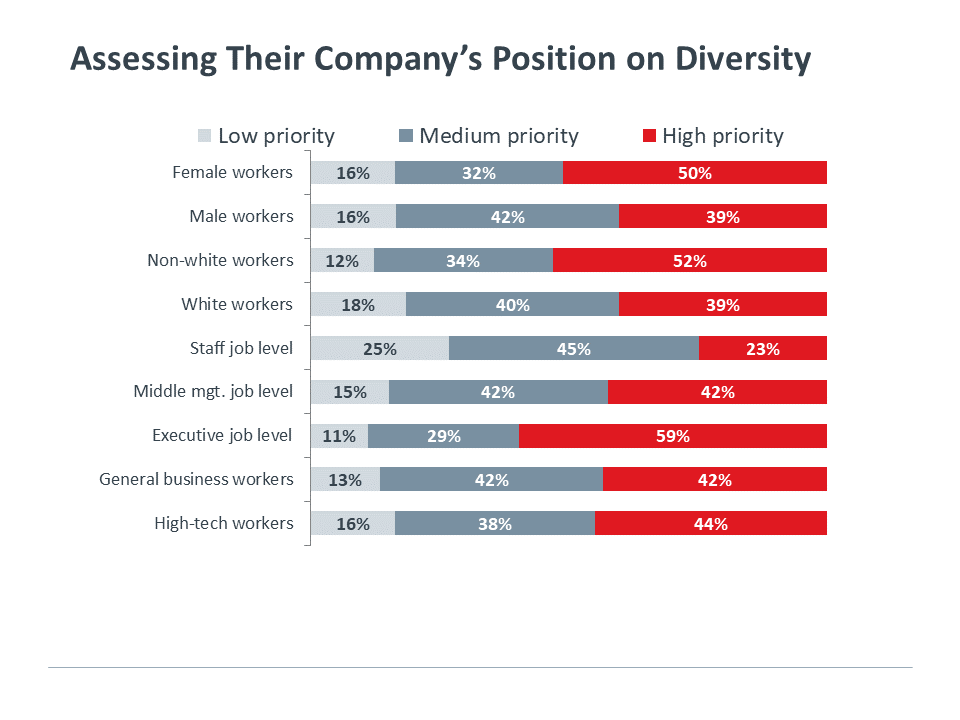



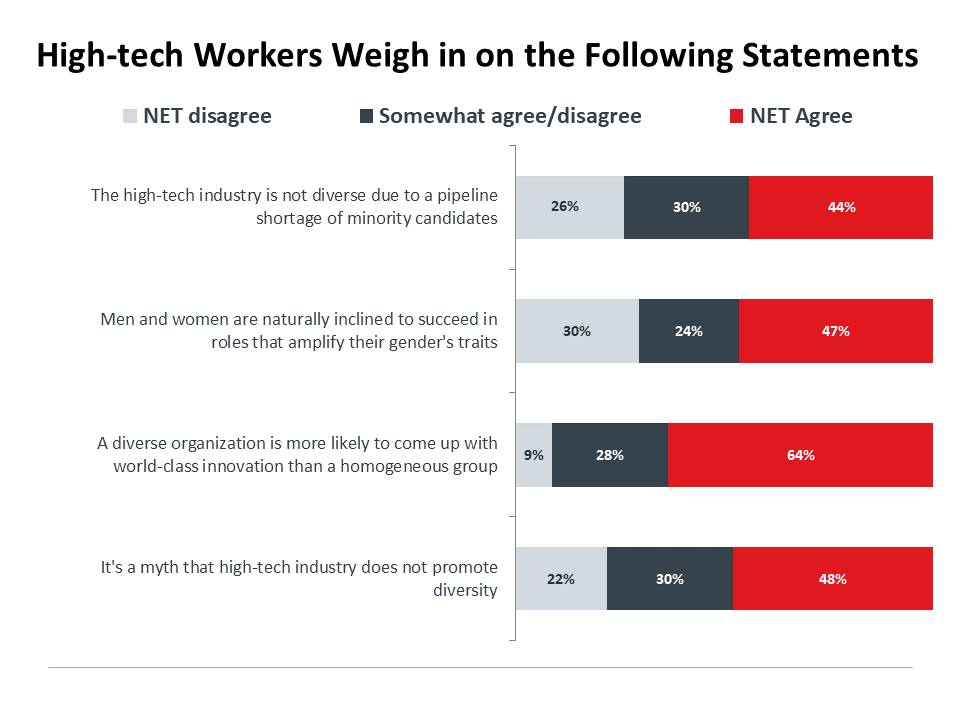

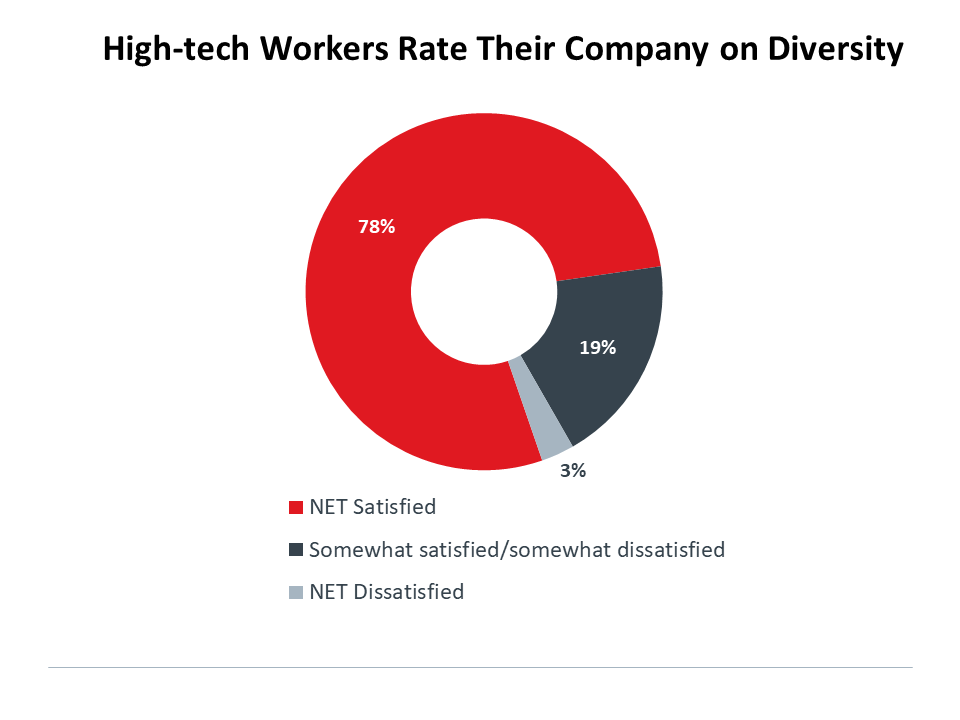
 Download Full PDF
Download Full PDF